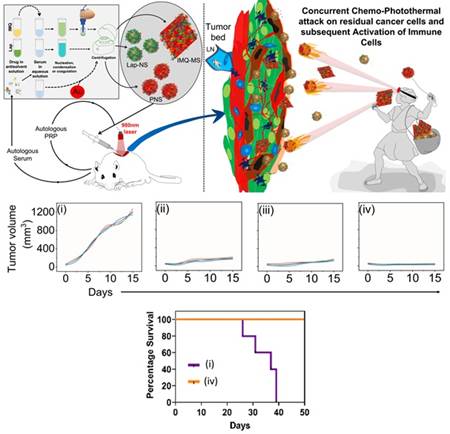Combination nanotherapeutic clotting implant reduces localized tumor recurrence post-surgery
Combination nanotherapeutic clotting implant reduces localized tumor recurrence post-surgery
A combination therapeutic implant consisting of metal-based nanomedicine reinforced with patient derived blood clotting components reduces localised tumour recurrence post-surgery.
The technology can be used to fabricate a therapeutic kit that can generate this autologous hybrid implant by using simple equipment such as handheld homogenizer and a centrifuge which might be beneficial to marginalised cancer patients.
Surgery and chemotherapy are inevitable in managing solid tumors. However, local recurrence due to residual tumor and systemic toxicity due to drug non-specificity confer these vital modalities inefficient. Nanotechnological tools show promise in reducing toxicity and improving solubility of chemodrugs, but due to their poor tumor bioavailability (<0.7% of injected dose) and rapid clearance by reticulo endothelial system, their progress is deescalated. A key obstacle is also the adsorption of host serum proteins over the surface of nanoparticles termed as ‘protein corona’.
Protein corona has been recently established as a molecular fingerprint of a patient and has been realized to be integrated into the basic design of nanoparticles for a futuristic personalized treatment strategy. Considering serum proteins being the first line of interaction for a drug molecule soon after its systemic administration, scientists are trying to devise ways in positively channelizing corona proteins towards generation of precision nanomedicines and diagnostic tools.
Scientists at Institute of Nano Science and Technology (INST), Mohali, an autonomous institute of Department of Science and Technology in collaboration with researchers from IIT Ropar, AIIMS Bilaspur and PGIMER Chandigarh have developed and tested an indigenous intra-operative combination treatment consisting of drug and metal-based nanomedicine stabilized by patient derived serum protein corona termed as Nano-Micro-Sera (NMS) and reinforced them into autologous fibrin to aid in the post-surgical management of locally recurrent tumors.
The hybrid fibrin implant quickly bonds with damaged tissue in the residual tumor bed. After closure of the surgical site, localized chemo-phototherapy impeded tumor recurrence through immunogenic cell death (ICD) mediated dendritic cell maturation and T-cell activation.
Although fibrin sealants are commercially available, autologously derived fibrin glue is also utilized favourably during mastectomy, maxillofacial and ophthalmological surgery. Due to its wide acceptance for such clinical procedures, strengthening it further with therapeutic functionality by incorporating NMS is highly warranted.
The autologous hybrid fibrin glue developed by the researchers exhibited remarkable synergy and superior outcomes in suppressing recurrent breast tumors. This host-specific approach published in the journal Nanoscale was meticulously crafted for bedside fabrication using minimal resources, addressing the limitations of conventional therapies and ensuring accessibility for patients across different economic conditions.
Considering the large number of patients suffering from solid tumors in India, an affordable methodology for localized post-surgical management will have significant impact in controlling recurrence of primary tumor and thereby affecting the probability for local as well as distant metastasis.
Publication link: DOI: 10.1039/d4nr01076k

Figure shows work flow for preparation of Nano Micro Sera (NMS) and its application at the tumor bed with hybrid fibrin glue that initiates concurrent chemo-photo thermal attack on residual cancer cells and further activation of immune cells. The combination nanotherapeutic fibrin implant (iv-NMS) effectively decreased post-surgical tumor regrowth in comparison to Control groups (i-autologous implant, ii-combination of chemotherapeutic drug and photothermal agent loaded fibrin implant and iii-immunoadjuvant loaded fibrin implant), thus improving overall survival.